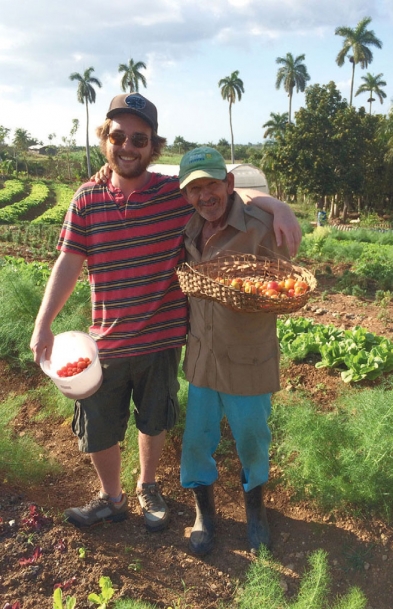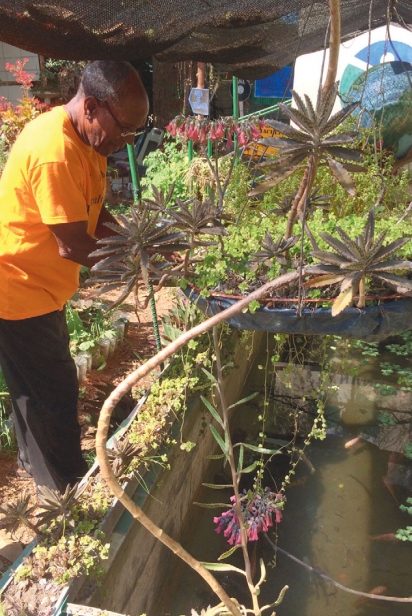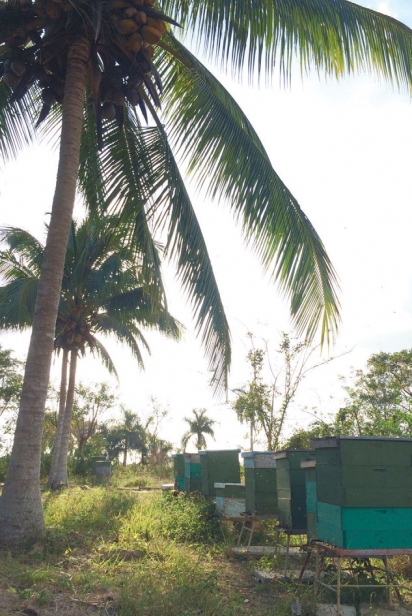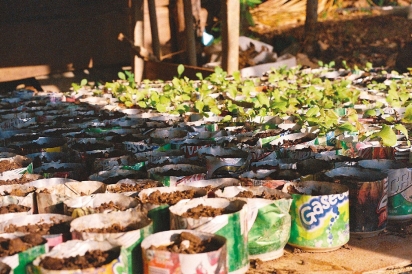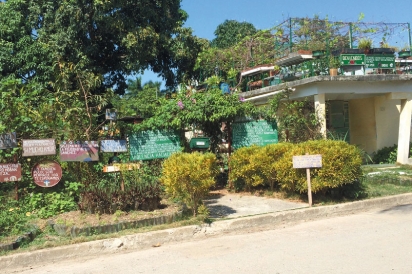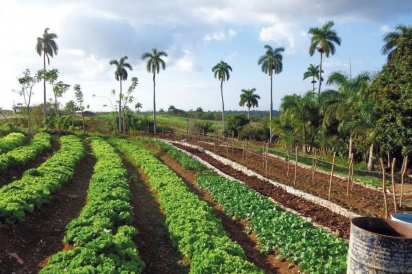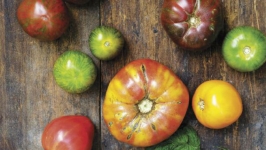Silas Peckham-Paul’s Introduction to Agriculture in Cuba
An Organic Farmer from Little Compton Finds Inspiration in the Gardens of Havana
Cuba is a land of stark contrasts: The average monthly income is $20 per person, yet the nation’s literacy rate of 99.8% is higher than that of the United States. The infrastructure is crumbling and Havana’s streets are dotted with vehicles dating from the 1950s, yet residents receive free, high-quality health care and much of their produce is organically grown.
When Little Compton organic farmer Silas Peckham-Paul learned of an opportunity to accompany a university group visiting Cuba to study agricultural practices, the trip was too enticing to pass up.
“I fell in love with the idea,” he said. “Like every American, I had a fascination with what it’s like there.”
The week-long trip in late winter was organized by the University of Vermont and Burlington College for two dozen students; Silas, age 25, was the one “outsider.” Fortunately, it coincided with a relatively quiet time for Wishing Stone Farm, where he was raised by his parents, farmers Liz Peckham and Skip Paul. Now farm manager, Silas said with a wry laugh, “When I left, everything was seeding and we were grafting tomatoes. I skipped out on a week of seeding, which was fine with me.”
A BRIEF HISTORY LESSON
Before the Cuban revolution in the late 1950s, almost half of Cuba’s agricultural lands were owned by 1% of its people. When Castro rose to power, agriculture was nationalized; land ownership by foreigners was banned; and land titles were granted to some 200,000 Cuban peasants. The U.S. imposed an embargo on trade with Cuba, with some exceptions for food and medicine. The Soviet Union agreed to buy five million tons of sugar over a five-year period and to support Cuba with oil, grain and credit. When the Soviet Union collapsed in 1990—91, Cuba lost $6 billion in annual economic subsidies and could no longer feed its people.
The collapse of the Soviet Union led to what Cubans ironically call the “Special Period,” a period in the early 1990s of widespread hunger and deprivation. While the average Cuban consumed some 2,600 calories each day in the 1980s, food and caloric consumption dropped precipitously during the “Special Period.” By 1993, the average Cuban was consuming only 1,000 to 1,500 calories each day, according to an April 3, 2008, story, “Cuba’s Organic Revolution,” in The Guardian.
With significant shortages of food, fertilizers and pesticides, Cuba was forced to improvise...and improvise it did. Adopting new initiatives, the Cuban government strengthened agricultural biodiversity, focused on small farmers, prioritized food production and allowed farmers to sell surplus produce directly to individuals. Lacking access to agricultural chemicals, farmers were forced to farm organically.
“They’d been growing tobacco and sugarcane for so long—two things that don’t exactly feed a population,” said Silas. “A lot of sugarcane factories closed down in the 1990s but I think tobacco farms are still up.”
CUBAN FARMS AND THEIR FARMERS
Cuban farmers are “definitely geniuses,” said Silas. “The whole Cuban way of being is almost forced sustainability. They’ve been left on their own for so long that they had to figure out how to do everything with what they had.”
Imagine growing produce in hard, rocky soil and plowing fields with decades-old tractors and/or horses. That’s the norm for Cuban farmers, including Fernando Funes-Monzote, the owner of Finca Marta (“finca” is Spanish for a “rural property” or “large farm”), where Silas’s group spent one afternoon. Silas opted to pick cherry tomatoes, rather than bananas and coconuts, so he could compare and contrast growing and harvesting practices of Finca Marta and Wishing Stone Farm.
“We picked produce for only about 20 minutes—the tourist version of working on a farm,” said Silas.
While many farming practices looked familiar to Silas, Finca Marta’s 30 beehives include some hives of pollinating, non-stinging bees indigenous to Cuba. Cool Caribbean colors of blue and pink adorn the Cuban hives.
Funes-Monzote, who studied agriculture in Amsterdam, converts his cows’ manure into methane gas, which becomes fuel for stoves that he and his employees use. “It was super sustainable; they think of everything,” said Silas, who noted that Funes-Monzote planned to supply methane gas to one of the restaurateurs who buys his produce.
Before venturing out on afternoon field trips, the group heard lectures each morning from different agricultural experts who discussed permaculture, sustainability, crop storage and seed exchanges, among other farm-related topics. The lecturers, said Silas, were the Cuban version of our extension agents, who normally visit farms to help farmers with various agricultural issues.
Lectures were held at the José Marti Center, which is housed in José Marti’s former residence and doubles as a museum and classroom venue, with a focus on agri-tourism. (Marti, a Cuban national hero and prolific essayist and journalist, became a symbol for Cuba’s desire for independence from Spain.) As an experienced farmer, Silas was knowledgeable about most of the concepts, yet he enjoyed hearing the Cuban perspectives.
RIOTOUS ABUNDANCE OF URBAN FARMING
“Waste not, want not” applies to Cuban life, even in urban Havana. Roberto Sanchez teaches Havana residents (not farmers) about permaculture and sustainable farming at his home, which he converted into Sanchez Permaculture, an urban farm with an outdoor classroom and a composting toilet.
When Silas asked Sanchez what lessons he should take home to Wishing Stone Farm, Sanchez told him: “Share knowledge with everyone.”
Silas continued, with a note of admiration in his voice, “To the untrained eye, it looks like a veritable dump but when you start looking closer, there’s stuff growing out of everything. I don’t think Sanchez has thrown anything out since the 1990s—it’s all being used.”
Sanchez Permaculture looked like “an insane children’s garden,” he said, noting that Sanchez grows an abundance of vegetables, including peppers, eggplants, rosemary and tomatoes at his small location. Like many Havana residents he too raises chickens. “Every single table had a little chicken underneath it,” said Silas.
On the outskirts of Havana the Community Food Preservation Project offers classes and publishes instructional materials so people can learn how to ferment, dry and pickle foods, herbs and spices. Founders José Lama and Vilda Figueroa, a husband and wife team, have written many books and have hosted a TV cooking program and a radio show. According to Silas, prices for the jams and jellies sold there were, surprisingly, on par with U.S. prices for comparable goods.
Most farms and urban gardens are organic because it’s difficult to find pesticides and fertilizers, said Silas, who expressed cautious concern about the future. He wonders, “What’s going to happen now when it seems like part of the embargo will be lifted . . . when some of the ‘bulls’ of agriculture in America come down and take over, will [the farmers] be accepting or start resisting?”
WHAT’S GROWING SUSTAINABLY IN CUBA?
Farmer or not, nearly everyone in Havana has a little garden. “On every street corner, [I’d see] little organic farms . . . on the roofs, spilling out into the streets,” said Silas. People barter a great deal in Havana; a carpenter might barter his carpentry services for mangos and melons, for example. Everyone from the neighborhood trades and barters, and people get much of their nutritional needs met through urban farm produce. Even a decade ago, some 90% of Havana’s fresh produce came from local urban farms and gardens.
At a permanent retail market, Silas readily recognized familiar produce— bananas, broccoli, cherry tomatoes, coconuts, eggplants, fennel, green beans, greens, peppers, root crops, rosemary, tomatoes and “some cool types of spinach that were almost like sorrel and very lemony,” he said. With “just enough Spanish [to get by],” Silas was unable to successfully decipher the names of unfamiliar root crops, vegetables and fruits.
Since his return, Silas has been dreaming of making Wishing Stone Farm a bit more Cuban.
“We have a children’s garden that I’d love to make more educational; I’d like to replicate Sanchez Permaculture,” he explained. On a personal note, he confessed to planting some tobacco seeds in Rhode Island. “I’ll see if I can roll some cigars and look like a total gringo,” he said, laughing.
“If Cuba could set up some agri-tours when the Americans are allowed there, they’d make a killing [demonstrating] how they do organic farming, with lectures, too,” he said.
While Silas doesn’t disparage the value of this academic trip, if he’d had his way, he “would have gone straight to a farm and camped out ... with a little bit more reckless backpacking,” he said. “I definitely will go back and check out more of the countryside.”


